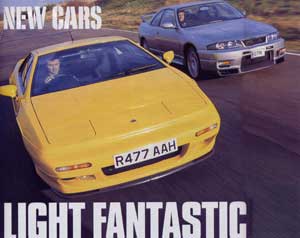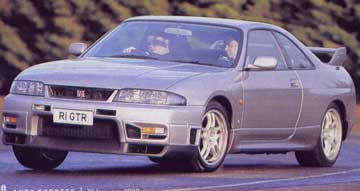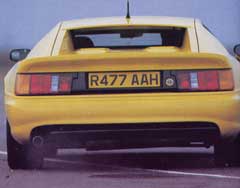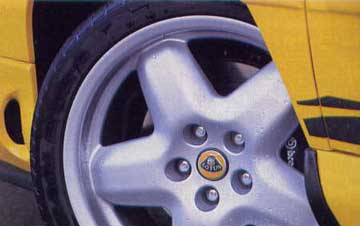

ROAD TEST: Lotus Esprit GT3 v Nissan Skyline
AutoExpress, 21st
January 1998
by Mike Askew
Deep within the Norfolk countryside something is stirring. The high-revving roar of turbocharged engines and the distinctive howl of tyres on tarmac fill the air. Sounds that will warm the heart of British supercar enthusiasts the world over, because they give warning that Lotus is about to unleash the latest evolution of the mighty Esprit.
If cars were humans, the Lotus Esprit would be about to receive its golden handshake and shuffle gently into retirement in Bournemouth. Fortunately for us, the Esprit is having none of this. Despite being launched back in 1976, it still has the power to turn heads like few other cars, and, thanks to a series of revamps over the years, looks just as great as ever. So what's the big news? Well, for 1998, the Esprit has been refreshed and rejuvenated in order to keep it on a level footing with its supercar opponents. There is a long-overdue interior redesign, and the car has been honed to make it sharper yet easier to live with.
The concept behind the GT3 is simple. Make it light, lean and lithe – just as Lotus founder Colin Chapman envisaged the car in the early Seventies. It also reflects Lotus's rediscovered commitment towards real performance cars. As with the stripped-out Elise, the GT3 does away with unnecessary gadgets and luxuries, all of which weigh the car down and blunt performance.

Compared to its supercar rivals, the GT3 is unique. Where most are putting on pounds as well as horsepower as the years go by, the Lotus is becoming lighter. To see whether the Lotus approach is really the way forward, we took a Nissan Skyline along with us for comparison purposes. Loaded with electronics, it has active four-wheel drive and, crucially, is 400kg heavier. In other words, the Japanese car is the complete opposite of the Lotus, with its lightweight frame, brute power and traditional rear-wheel drive.
The Esprit's trump card is undoubtedly its new interior. For too many years Lotus's flagship model has had to make do with one of the worst cabins in the supercar world. Despite undergoing various low-budget attempts to improve it, the Esprit's dashboard was, frankly, appalling. Poorly placed switchgear, too many unnecessary dials and a bad ventilation system were enough to put off the most ardent Lotus fans. Thankfully, all that's changed in the new model.
Engineers and designers started from scratch and left no stone unturned in their drive to improve the Esprit's cockpit. The wide wraparound instrument binnacle has been replaced by a more compact item, which neatly houses the speedometer, rev counter and gauges for temperature and fuel. The new dials are wonderfully clear and a vast improvement over the old ones – as too is the centre console which now blends in neatly with the rest of the dashboard. Made from soft plastics, and punctuated with flush-fit heater vents, the design is simple and effective.
A brand-new heater system, with controls sitting in a small recess, has also been installed. Gone are the inaccurate cable-operated vent controls, replaced by solid switches which do the job perfectly. The heater pipework has also been re-routed, which means that poor ventilation will be a thing of the past. There is still a sprinkling of General Motors-sourced buttons and controls in evidence, but they've been integrated well and don't detract from the new cabin's overall appearance. The transmission tunnel has been lowered and made slimmer to give more leg and elbow room for occupants, and benefits from being coloured in the same soft-feel vinyl as the instrument binnacle.

As well as looking and feeling better than before, the Esprit cockpit is also more practical, small pocket attached to the rear bulkhead and situated between the two seats is large enough to hold a small mapbook or CDs, while the glovebox is bigger and more practical. And in line with the GT3's philosophy of keeping weight to a minimum, equipment levels are relatively sparse. Despite our test car being fitted with one or two extras, standard GT3s come without a radio or air-conditioning.
Although the two bucket seats look sparsely trimmed, they are remarkably comfortable. Well shaped and with impressive levels of side and under-thigh support, they hold you tightly but never feel cramped. They look the part, too, with the seat's shiny fibreglass shell showing at the sides. The overall effect of these changes is remarkable. Now the Esprit has an interior which can live with the best offerings from its rivals, Nissan included. The Skyline looks too mainstream to be special, with a design which is more Serena than supercar. Sure, it's comfortable with great seats and a good driving position but, unlike the Esprit, it doesn't get the pulses racing.
The man behind the changes is Esprit platform manager Brian Angus, He's worked on the Esprit line for 18 years, and reckons the 1998 model year car is the best yet. 'The car's been crying out for a new interior for years, but there's always been something more important to do with it and the budget,' he said. However, the Esprit's exterior remains unaltered. Its wedge-shaped body is beautifully simple, and shorn of the unpleasant wings and wheelarch blisters that have been tacked on in recent years.
Of course, with a basic design that dates back two decades, your eyes can focus on the occasional harsh edge, but overall, the Esprit still has an uncanny ability to turn heads. Its standard 17-inch alloy wheels fit snugly under the wheel-arches and give the car a mean stance, while the bespoke Goodyear tyres ensure plenty of contact between the GT3 and the road surface. Lurking under the large fibreglass engine cover is the GT3's mighty heart – a turbocharged 2.0-litre engine developing 240bhp.

Essentially the same unit which the Esprit was launched with in 1976, the four-cylinder lump has given sterling service over the past two decades and is now better than ever. Helped by a large watercooled turbocharger, it's light but delivers explosive power. Given a dry road the GT3 is capable of racing from 0-60mph in just five seconds, and, on a track, can crack 100mph in 12.9 seconds. Compared to the Nissan's twin-turbo straight six, the Esprit's unit is relatively low-tech, but despite this, is only 20bhp down on power. And because its body is the lighter of the two, the Esprit is quicker when placed back-to-back.
On the road, the Esprit is as sharp as ever, with revised suspension settings making the chassis even more rewarding. The power-assisted steering feels beautifully weighted and incredibly direct at all speeds. It feels like an overgrown go-kart, and rewards a keen driver in a way few other cars can. Lotus's engineers have also managed to strike an exquisite balance when it comes to the Esprit's ride and handling. Despite stiff springing which keeps body roll to the absolute minimum, the ride is surprisingly supple. The brakes also come in for praise, thanks to the introduction of a new lightweight ABS system.
It replaces the crude Delco set-up which used to cut-in too early and release too late, and lets you brake harder and later with more confidence. Overall, the Esprit delivers a very pure driving experience, especially when compared to the hi-tech fell of the Skyline. Although the electronics do a superb job of keeping the car in check – preventing spins by constantly varying the drive to each wheel – it feels complicated and almost cumbersome at times. We love the way the Nissan manages to flatter everyone who drives it, but the Lotus triumphs when it comes to raw driver appeal.

Lotus has spent more than half a million pounds on the Esprit's revamp, and although the lion's share of the money has gone on the interior, there are a number of major changes that will affect the rest of the range. The drivetrain of the range-topping V8 has been extensively reworked after criticism of its heavy gearchange and high-speed vibrations. In addressing the problem, Lotus engineers worked closely with gearbox supplier Renault, and their research resulted in a redesign of the gearshift and clutch operation. Although still cable-operated, the V8's shift is now lighter and more precise, while the new dual-plate clutch is easier to use. For the time being, the GT3 will retain the old linkages, although when production of the new system is up to speed, it will be installed. Perhaps the best prospect for Lotus fans in this round of modifications in the introduction of a new model, the Esprit V8 GT. Combining the stripped-out body of the GT3 but with the powerhouse V8 engine installed in the back, it promises to deliver the best of both worlds. It's due to arrive in the next three months.
With a price tag of £39,995, the GT3 undercuts many rivals; it's £10,000 cheaper than the Skyline here. It lacks luxuries in standard form, but shattering performance and a superb chassis make it something special. Just as the Lotus Elise rewrote the rules for two-seater roadsters, the new GT3 seems set to do the same for supercars.
1st OPINION
When Lotus introduced its lightweight GT3 last year as a special edition, it was an instant hit. Now that it has a permanent place in the Esprit range, the package looks even more convincing. An all-new interior has liberated more space and given the '98 Esprit the supercar feel it lacked.
A light body and 2.0-litre turbocharged engine gives shattering performance, despite power delivery being blighted by an ageing engine and turbo lag. The new ABS system lets you brake harder than ever before; even in the wet, the Esprit inspires confidence in a way few rivals can. Supercar ownership has just got a step closer.
At a glance
• 1998 model year Esprit gets long-overdue new interior
• GT3 weights 150kg less than fully trimmed V8 Esprit
• 0-60mph in five seconds, top speed 159mph
• Available now for £39,995 on the road
|
|